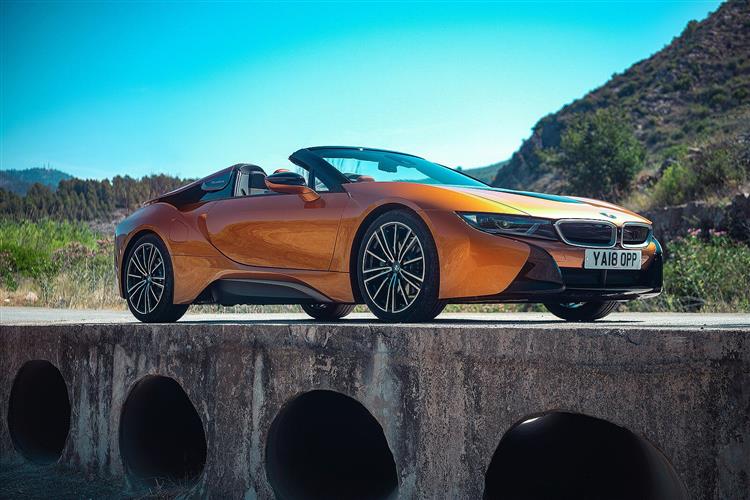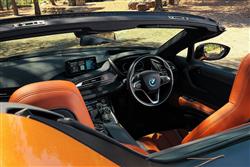THE CLEANER GERMAN OPEN (some text hidden) SECTIONED_new_bmwi8roadster_2019
By Jonathan Crouch
Introductionword count: 100
The BMW i8 aimed to re-define the art of sports car design - both technologically and aesthetically in this Roadster guise. It may not be the ultimate contender of its kind from the 2018-2020 period to drive but it could well be the ultimate model of this type to own. This is, after all, a plug-in petrol/electric hybrid super sports car that runs silently on its battery in the morning commute, yet can transform itself into a high performance GT when you're in the mood. It also looks sensational, feels special and will slash your running costs to the bone.
Modelsword count: 2
2dr Roadster
Historyword count: 400
You're looking at a model that claimed to represent the future of open-topped sports cars. One that was light, strong, very fast and more than able to justify its position on the planet. Welcome to BMW's revolutionary i8 Roadster, sold briefly between 2018 and 2020. You might be familiar with the i8 Coupe, the model that democratised sophisticated hybrid technology in the high performance super sports car segment. Until this revolutionary model arrived in mid-2014, plug-in petrol/electric sportscar motoring required the billionaires' budget needed for ownership of hypercars like the Porsche 918 Spyder, the La Ferrari and the mighty McLaren P1. At a stroke, this BMW changed all of that, delivering an equally sophisticated taste of the future, but doing so for realistic Porsche 911 money. Originally, BMW designed the i8 as a Coupe, but showed a Spyder concept version at the Beijing Motorshow in 2012 to see if there would be enough customer interest in an open-topped version. There was and when the design team removed the roof of a fixed-top model and found the carbon fibre chassis easily stiff enough to support a convertible format, the Munich maker gave the green light for production. Following which the i8 Roadster was launched in the Spring of 2018. It arrived on the market at the same time as the i8 Coupe was receiving a significant update, most notably to its rather unique powertrain. That's based around the use of two gearboxes, three electric motors and a sophisticated three cylinder turbo petrol engine, this boosted by a 200kg bank of hi-tech lithium-ion batteries and transmitting torque to the tarmac via a four wheel drive system. As part of the mid-term improvements, BMW has added 12hp to the engine output, while upgrading the cell capacity of the lithium-ion battery to 34Ah and increasing its energy capacity to 11.6kWh, in the process raising this car's potential pure electric driving range by 10 miles to 33 miles. It was all enough to further distance this i8 from its conventional super sports car rivals. And in this Roadster form, buyers got an extra element of exotic desirability. But would you really pay Porsche 911 money for a three cylinder 1.5-litre Plug-in hybrid convertible? We think you might if you're in the market and have half a care for the environment. The i8 in both Coupe and Roadster forms sold until 2020 - and wasn't replaced.
What You Getword count: 507
Even standing still, there's a sense of theatre about this i8, with a riot of complex surface treatments, contrasting colours, sharp creases and scalloped sills. For this Roadster version, BMW revised this car's distinctive dihedral doors to integrate frameless windows and better fit with the new roof arrangement. It's a fabric top that activates in 15 seconds at speeds of up to 31mph, folds in a Z-shape and stows vertically in the space where tiny back seats would be in the Coupe model, nestling between the rear bulkhead and the mid-rear-mounted combustion engine. As ever in an i8, the packaging is necessarily intricate, given the need to accommodate two gearboxes, three electric motors, a three cylinder turbo petrol engine, a 200kg bank of hi-tech lithium-ion batteries and all the associated technology of 4WD. It's all built into what the brand calls a 'LifeDrive' design approach, the name designating the two separate platform segments that combine to create the underpinnings of this car. First up is the aluminium 'Drive module' that shrouds the combustion engine and electric motor, the battery pack and various power electronics and chassis components. This connects to the separate 'Life module', the name BMW gives to this i8's CFRP 'carbon-fibre-reinforced plastic' passenger cell. Because of this, the designers of this Roadster model didn't need to build in additional structural reinforcement to make up for the removal of the roof. There are some additional panels in the rear suspension and the strengthened windscreen frame is fashioned out of reinforced CFRP, but that's about it. In the cabin, you'll find the styling as futuristic as it was outside, the curved, layered dash made up of overlapping three-dimensional segments and complemented by contrasting colours. Cocooned yet surprisingly roomy, the driver-focused cockpit envelopes you with slender blue-stitched leather sports seats, re-designed here as part of a package of mid-term i8 updates that also included the standard inclusion of these carbon fibre trimming panels and the addition of touchscreen functionality for the 8.8-inch iDrive infotainment monitor positioned at the top of the dash. Most arresting though, is the display you view through the grippy three-spoke wheel, a sci-fi-style screen, also 8.8-inches in size, which delivers range readings for fuel and battery power below two circular digital dials that change in colour depending on the driving mode you select. On to interior practicalities and, as is the sports car norm, cabin storage space is somewhat limited, not helped here by the fact that there are no door pockets. Obviously, the deletion of the Coupe model's rear seats doesn't help either, though to compensate, BMW provided 100-litres of storage capacity between the roof box and the seat backs, which is compartmentalised into three parts and is ideal for stuffing coats and soft bags into. Let's finish with a look at boot space. It's just as well that that extra space behind the seats was freed up because there isn't much room available in the boot - just 88-litres - around half the trunk space offered to buyers of the Coupe version.
To see the full road test text contact us on 0330 0020 227
Pictures (high res disabled)

.jpg)
|
.jpg)
|
.jpg)
| |||
.jpg)
|
.jpg)
|
.jpg)
| |||
.jpg)
|

|
Scoring (subset of scores)
Category: Sporting Cars
| Performance | |
| Handling | |
| Comfort | |
| Space | |
| Styling, Build, Value, Equipment, Depreciation, Handling, Insurance and Total scores are available with our full data feed. | |



